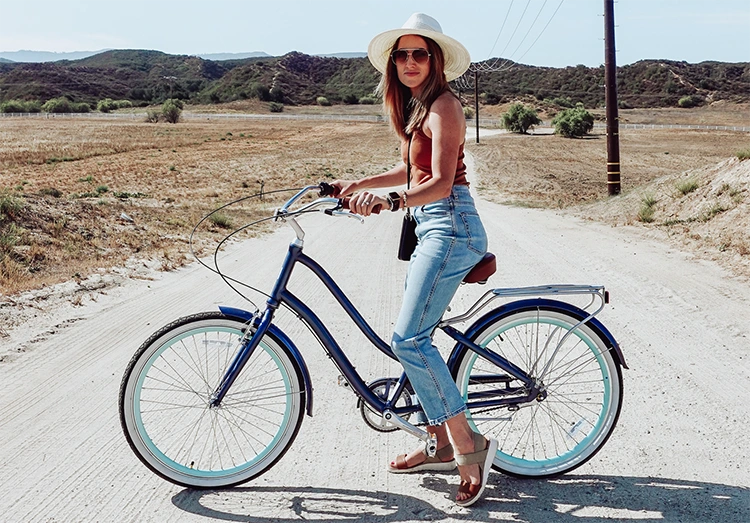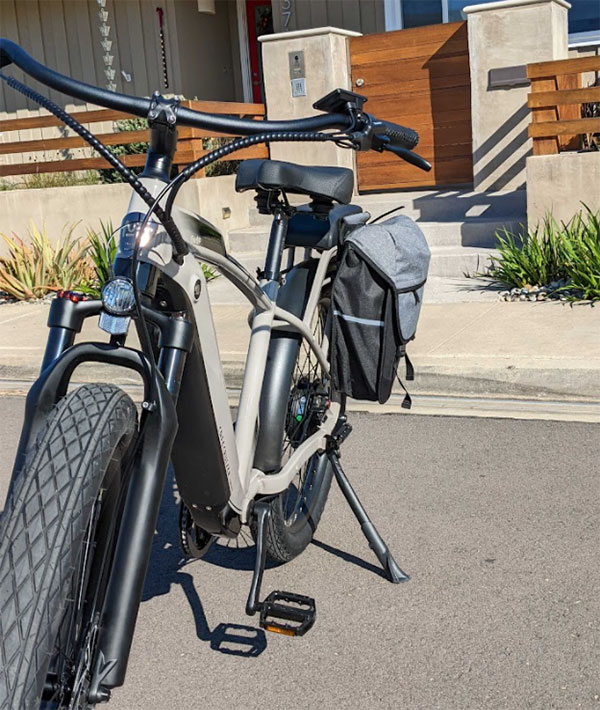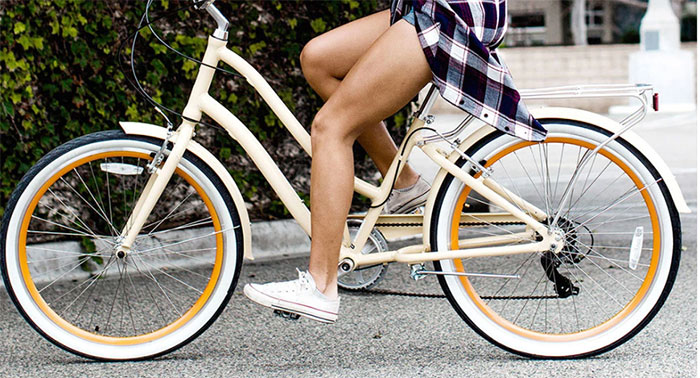Buying a cruiser bike sounds simple—pick a comfy seat, some wide tires, and you’re good to go, right?
I thought so too.
But once you dig in, you realize there’s more to it.
From gears to brakes, storage space to maintenance, every choice changes how much you’ll actually enjoy your rides.
Looking back, I wish I had known these 11 things before rolling my cruiser out of the shop.
Contents
- 1. Cruisers Can Be Heavy
- 2. Storage Is Harder Than You Think
- 3. Gears Are Not Just a Luxury
- 4. Electric or Pedal?
- 5. Tires Change the Ride Completely
- 6. Upright Riding Position Isn’t Always Best
- 7. Regular Maintenance Is a Must
- 8. Not All Brands Are Equal
- 9. Not All Cruisers Are Great for Long Rides
- 10. Popular Choice Doesn’t Always Mean Best for You
- 11. Accessories Add Up
- Final Thoughts
1. Cruisers Can Be Heavy
Have you ever picked up a beach cruiser bike and felt like you were lifting a piece of old farm equipment?
That’s exactly how I felt the first time I tried to carry mine up a few steps. The wide tires, solid steel frame, and upright riding position make cruisers a popular choice for leisurely rides along boardwalks. They roll smooth and steady, like a Cadillac on two wheels.
But here’s the catch: that extra stability comes with weight. Cruisers can be hard to push up hills, tricky to load onto bike racks, and a real workout if you’re riding longer distances.
Consider: if you’ll stick to short, flat rides, weight won’t matter much. But if you need to haul your bike upstairs, lift it into a car, or cover lots of miles, look for a lighter frame or aluminum build.
2. Storage Is Harder Than You Think
Have you ever tried squeezing a cruiser bike into a hallway closet? I did once, and let’s just say the door didn’t shut. Cruisers aren’t exactly compact—not even on a car rack.
Between the wide handlebars, long frame, and big tires, they take up more space than most people expect.
If you live in an apartment or a house without a garage, storage quickly becomes a puzzle. Wall mounts help, but you’ll need strong anchors.

Vertical racks can work, but lifting a heavy cruiser daily isn’t easy. Even in a garage, two or three cruisers can eat up valuable space meant for bins, tools, or other gear.
Consider: before buying, decide where your cruiser will live. Measure your space, consider wall or ceiling racks, or reserve a corner so your bike doesn’t become a tripping hazard.
3. Gears Are Not Just a Luxury
Remember the first time you tried pedaling up a hill? Legs burning, lungs gasping, wishing you could magically make it easier?
That’s what gears are for. When I first looked at cruisers, I thought a single-speed setup would be simpler and truly low maintenance. And yes—for flat paths and a relaxing ride, it is.
But the moment you meet a long climb, those extra gears suddenly feel like a gift. They let you shift into a comfortable rhythm instead of grinding through every pedal stroke. Even rolling back downhill, gears help keep your pedaling smooth and controlled.
Consider: choose your gearing for your environment. If your rides are flat and easy, a single-speed will serve you well. If you’ll hit hills or longer stretches, invest in a 3-speed or 7-speed cruiser for comfort.
4. Electric or Pedal?
One of the biggest choices today is whether to go fully pedal-powered or add a little electric boost.
Both give you that classic cruiser style, but the ride feels very different.
Sixthreezero and Electra shine with traditional pedal cruisers, built for comfort and easy, leisurely rides along boardwalks. Their frames, saddles, and geometry are designed to keep you upright and relaxed.
On the other hand, brands like Aventon and Ride1Up bring modern e-cruisers to the mix. With pedal assist or throttle, you can glide farther, tackle headwinds, and enjoy hills without breaking a sweat.
Schwinn stays a reliable choice for affordable options, offering both classic and e-cruiser styles. And Priority Cycles stands out with belt-drive cruisers—smooth, quiet, and almost maintenance-free, whether electric or pedal.
Consider: if you love the pure simplicity of biking, stick with pedal cruisers. If you want extra range and less effort, an electric cruiser will keep you riding longer and smiling more.
5. Tires Change the Ride Completely
Ever swap bikes with a friend and notice how different the ride feels? Tires are a big reason why.
Wide tires give cruisers that stable, cushy feel—they soak up bumps and float smoothly over cracks in the pavement.
But wide also means heavier and a little slower. Narrower cruiser tires, meanwhile, roll faster but sacrifice some of that signature “glide.”

When I first bought my cruiser, I didn’t realize how much tire size mattered. The classic balloon tires looked cool and rode soft, but made longer rides harder. Later, I tried slimmer tires and suddenly cruising felt quicker—though a bit less plush.
Consider: if comfort and stability are your top priorities, stick with wide balloon tires. If speed and lighter handling appeal more, go with a narrower option.
6. Upright Riding Position Isn’t Always Best
At first glance, an upright riding position looks like perfection. Sit tall, relax your shoulders, and enjoy the breeze.
That’s the classic cruiser experience. I loved it for leisurely rides along the boardwalk. But on longer rides, I noticed something: my back and arms started to feel tired.
That fully upright posture is great for short, casual trips but not always the most efficient for distance.
A slightly forward lean can actually take pressure off your spine and give you more control when steering.
Consider: decide what’s most important. For casual rides and maximum comfort, upright is perfect. If you’ll ride longer or faster, look for a cruiser with adjustable handlebars or geometry that lets you lean just a little forward.
7. Regular Maintenance Is a Must
When I first bought my cruiser, I figured it would be “set it and forget it.”
After all, no suspension, no fancy parts—what could go wrong?
Turns out, even cruisers need regular maintenance. Chains stretch, rim brakes wear down, and tires slowly lose air. Even if you only ride on weekends, little things add up.
Don’t overthink it.
I was surprised by how quickly a squeak or wobble showed up. A five-minute cleaning or a quick brake check usually fixed it, but ignore it too long and the problem grows. Like any bike, cruisers run better and last longer when you give them a little attention.
Consider: make a simple routine—wipe it down after rides, pump your tires every week, and keep the chain oiled. Small habits keep your cruiser smooth and ready.
8. Not All Brands Are Equal
Cruiser bikes may look similar, but the brand you choose can change the whole ride.
Sixthreezero is known for ultra-comfy frames and wide saddles, perfect for beach paths.
Electra brings style and smart geometry that makes pedaling feel effortless.
Aventon and Ride1Up offer electric cruisers, giving you extra power for longer boardwalk rides.
Schwinn remains a classic, delivering affordable and reliable cruisers you can find almost anywhere.
And Priority Cycles stands out with belt-drive models—smooth, quiet, and nearly maintenance-free.
Consider: pick a brand that matches your riding style—comfort, value, or electric power—so your cruiser feels like it was built just for you.
9. Not All Cruisers Are Great for Long Rides
When I first rolled out on my shiny new cruiser, I imagined endless adventures—miles of boardwalks, city streets, even weekend trips.
The truth hit me around mile six: my legs were tired, my seat felt less cozy, and those big balloon tires weren’t exactly built for speed.
Cruiser bikes are designed for comfort and style, not endurance. They excel at leisurely rides, slow paces, and short trips to the beach or café. But take them too far, and their weight, upright riding position, and simple gearing start to show their limits.
Consider: use your cruiser for what it does best—short, comfortable, relaxing rides. If you dream of long-distance trips, a hybrid or touring bike may be a better companion.
10. Popular Choice Doesn’t Always Mean Best for You
Cruisers are a popular choice for good reason. They’re comfortable, stylish, and fun. But just because everyone in your neighborhood has one doesn’t mean it’s automatically the right bike for you.

Some people discover they want to go faster, ride longer, or climb hills without feeling drained. Others realize they love the relaxed pace and wouldn’t trade it for anything. The key is knowing your riding style, not following the crowd.
Consider: think about how and where you’ll ride most. If you want comfort over speed, a cruiser will make you happy. If you crave distance or performance, another bike type might fit better.
11. Accessories Add Up
When I first priced cruisers, I thought, “That’s not so bad!” What I didn’t realize was how quickly extras would raise the total bill.
A basket for groceries, a bell for safety, lights for evening rides, maybe a rack for carrying bags—it all adds up.
Cruiser bikes often come bare-bones, which is part of their charm. But once you start adding those fun accessories, you’re investing more than you planned. That’s not a bad thing—it’s part of making the bike truly yours.
Consider: budget a little extra for accessories. A basket, lights, or a comfy saddle can transform your cruiser from “just a bike” into your perfect ride.
Final Thoughts
Cruiser bikes aren’t perfect for every type of riding, and that’s okay. They were never meant to be.
They’re built for comfort, easy handling, and the kind of leisurely rides where you actually enjoy slowing down.
If this writing helped you understand that a cruiser bike might be for you, then go for it.
Don’t overthink it.
If you imagine yourself gliding along boardwalks, sitting in that upright riding position, and smiling through a relaxing ride, then a cruiser isn’t just the right choice—it’s the perfect choice for your lifestyle.


